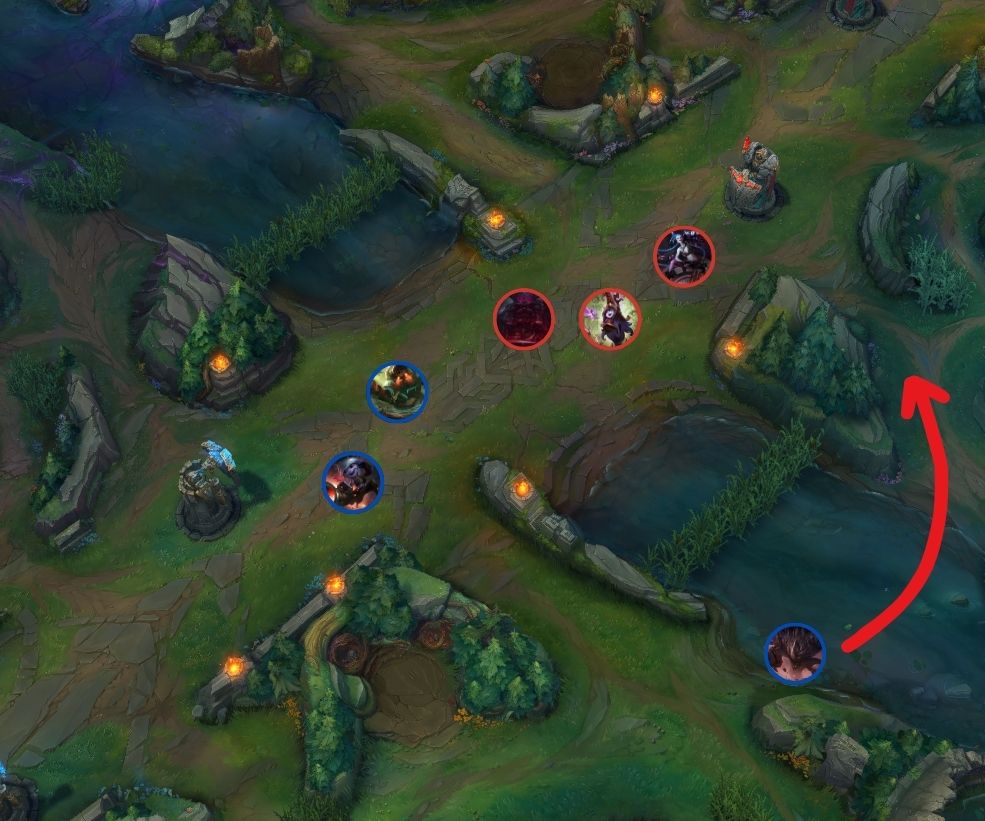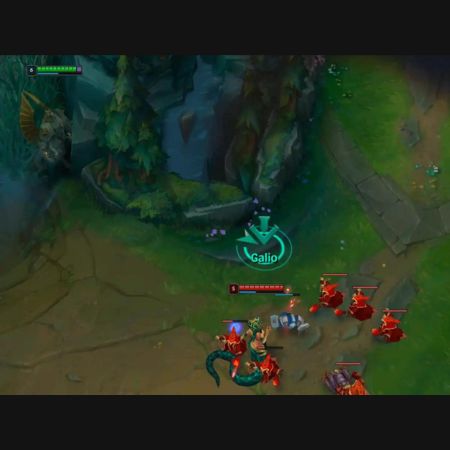In a fast-paced teamfight, strategic maneuvers and communication can often decide between a win and a loss. Among these strategies, flanking stands out as a potent tactic that can turn the tide of battle when executed correctly, even coming to entirely define the assassin role. Let's delve into what flanking is, why it’s effective, when it's effective, and how to carry out a successful flank.
What is Flanking?
Flanking in League of Legends refers to the act of positioning yourself or your team in a way that allows you to attack your opponents from a side or from behind, rather than from the front where they are expecting you (what people may call "playing front to back", as in literally dealing with the frontline before getting to the backline). This maneuver is often used to catch enemies off guard, disrupt their formation, and force carries into an unfavorable position.
Flanks are generally the best way to start a fight, because it requires the enemy to react unfavorably. This is why Fiddlesticks' ult can be so gamechanging—the enemy is suddenly preoccupied and scattering, and won’t be able to properly respond to a followup..

Why is Flanking Effective?
Flanking is effective for several reasons:
- Element of Surprise: By engaging from an unexpected angle, you can catch enemies off guard, leading to panic and disarray. The difference between starting out a teamfight with Ornn or Kled ultimate, and starting it with a Fiddlesticks ultimate over the wall is easily 2-4 seconds of guaranteed damage as the enemy team attempts to reposition in response to the engage.
- Disruption: When executed properly, flanking forces the enemy team to reposition to respond to your dive, often leading to mistakes or catch-22 situations. For example, flanking around the frontline and diving the backline can force the entire backline to focus on you, and be unable to respond to their own frontline engaging. If you manage to go trade kills with a carry and get some heat off of your tank by disrupting the backline, you’re putting your team ahead in resources in the fight.
These kinds of flanks are specifically nasty when you have a way smaller frontline than the enemy team's. By flanking in response to your own frontline being engaged on, you can invalidate even the biggest, meatiest frontlines. Engages don't matter without followup damage.
- Backline Access: Flanking allows you to collapse onto priority targets and carries more easily. If you loop over from the back, you can even close out their only route of escape, forcing them to take the fight instead of disengaging.
- Splitting the Team: A successful flank isolates key members of the enemy team, making them unable to control space around the teamfight. For example, this can keep mages like Aurora or Brand from being in position to ult safely, or even split the teamfight entirely into two smaller skirmishes, where the effect of big, teamfight-winning ultimates will be diminished.
How to Flank Effectively
Vision Control
Vision is your highest priority when attempting a flank. Without proper vision, you risk being baited into a bad fight, or being spotted before you can execute the flank.
Always pack a control ward and a sweeper if your job in teamfights mainly involves flanking, and clear vision around chokepoints. Be sure of how many people will be joining the fight, and bait the enemy team into situations where they need to contest for objectives without vision.
To improve your game experience and reduce frustration in ranked matches, consider starting fresh with a level 30+ unranked smurf account. It’s an easy way to bypass early grinding and jump straight into competitive play.
Timing
- Synchronize with Your Team: Coordinate with your team to ensure that they know you're flanking. Even if it's a bad flank, or if your team's engage wasn't perfect, accept that you may need to commit to it regardless.
- Track Cooldowns: It's best to go in for a flank when you see important and adaptable cooldowns. It's not uncommon for people to slip important cooldowns just to clear waves when preparing for a siege or objective. Examples include Neeko E, Lissandra W or Aurelion Sol E.
- Capitalize on Distractions and Mistakes: Your flank should never be the only thing that's happening, nor should you be going in completely on your own. Make sure that your engage has at least some use to your team, even if you get immediately bursted down.
Champions
Generally, most champions can attempt to flank, but they will do so for different reasons. It’s important to know what your objective is when setting up to flank a fight.

- Tanks: The main tank should only flank in two circumstances: diving or baiting. If you want to full dive onto the enemy backline, flanking the fight can enable you to initiate onto squishies, force mobility cooldowns, and allow your other divers to rush in and clean up. This can also work to split a fight, letting you isolate and kill an enemy frontliner. The second, more interesting one, is to flank their frontline. Get yourself out of vision, and try to get their frontline to commit some cooldowns; then go in, and you have an advantageous front-to-back, with all of your peel cooldowns landing easily.

- ADCs: ADCs should flank to clean up, after major cooldowns are spent, when the teamfight flow is more of a scatter rather than a front to back. For example, if you're playing Twitch against a rush/dive comp, you should look to flank. Try to get them to dive on your mid laner, support, or other carry while invisible, make them blow their engage cooldowns, then unload your kit. Similarly, if you're too behind to kill their tanks, flanking on ADC may be the only way your team can win a fight at all.

- Mages: Mages should flank for enfilading fire; it's all about creating skillshot pressure from off angles when flanking on a mage, especially from out of vision. By encircling the fight (still at a safe distance from your peel) you can sometimes catch an unsuspecting target like the support or enemy mid with CC, giving your team a really good engage.

- Assassins: Assassins should almost always flank the fight, as they have the tools to get backline access and their main objective is to kill squishies. The question becomes when they shouldn't be flanking. If they have no stiff frontline, it's sometimes better to front to back on an assassin. Champions like Vi, Xin, Camille, Fiora, etc, can be vulnerable to burst, especially if key cooldowns aren't up. If that's the closest thing the enemy has to a tank, it can often be worth it to just blow them up.

- Fighters: Fighters have more of a privilege to choose between front to back and flanking. On one hand, they're often durable enough to stand on the frontline and tank some skillshots, getting some space for their carries, while also having CC to punish mistakes. The issue with this is that their engages are often only reactive. They can't force an engage like a Malphite or Ornn could.
On the other hand, fighters can be great backline disruption, completely splitting the fight. Some bruisers (like Red Kayn, Aatrox and Briar) can even build full lethality and exclusively spec into backline disruption as a wincon.

- Enchanters: Enchanters generally won't want to flank fights, but some can actually chase a fed flanking champion around to enable them. The issue is not only that they do not have enough mobility to follow a hypermobile assassin or diver around, but also that their peel is most of the time more consistently useful to use on their own backline.
Flanking Tech Examples
Pincer
Pincer manoeuvres involve splitting from your team to surround the enemy from different angles. This can be incredibly effective in narrow spaces like the jungle, where enemies have limited escape routes.
Trying to pull off a pincer isn't recommended if you don't know for sure if you'll win the fight, but it's mostly used to squeeze maximum value out of an already favourable fight. The issue is that the flanking champion needs to be ahead enough to survive the entire backline, have some sort of self-peel (Zhonyas, Fizz E, Vladimir W for example), or to be followed around by an enchanter with peel.
Baiting
Baiting consists of having a few champions slip up intentionally or stay in a disadvantageous position, in hopes that the enemy team will go for a risky play, and then punishing their engage. The goal of baiting is to lure the opponent into an unfavourable situation, such as a hidden ambush, turret dive, or overextending into dangerous territory where your team is ready to capitalize on their mistake.
Some common scenarios and examples include:
- Baiting Objectives: Pretending to start or contest a neutral objective, prompting the enemy team to contest it, and then turning around and engaging.
- Bush Baiting: Luring enemies into an unwarded bush where your team is waiting to engage.
- Recall Baiting: Noticeably starting a recall in front of your opponent, prompting them to try and cancel it. If they don't have any ranged options to do so, it's a good way to get them out of position and perhaps even missing an important cooldown, setting up a good situation for your jungler.
- Baiting Towerdives: Staying while low under tower with a minion disadvantage to goad the enemy laner, sometimes along with their jungler, into a towerdive, while your jungler hovers your lane to punish.
TP Flanking
TP Flanking refers to being somewhere else on the map, most of the time a sidelane, and TPing to a ward behind enemy lines as soon as a teamfight starts. This is most effective for bruisers and divers that have issues flanking around the fight.
Although TP does give a free flank to powerful bruisers like Riven and Renekton, most of the power of TP flanking lies around tempo. Since TP takes a few seconds to channel, you won't be jumpscaring anybody, but what you will be doing is forcing the enemy team to make a choice between disengaging, or committing even harder to a fight to get a good position before your TP channel ends.
Common Mistakes to Avoid
1. Overcommitting Without Vision
Flanking without proper vision can lead to getting easily collapsed on by the enemy team. Always ensure that the area you’re flanking into is warded or has been cleared of enemy wards. Use control wards and sweeper trinkets to maintain vision control.
2. Bad Timing and Miscommunication
Engaging too early or too late can leave your team vulnerable and uncoordinated, or wind up with you simply being bursted down without using up any of the enemy team's resources. Communicate with your team and ensure that everyone is ready to engage before you start the fight. Wait for the right moment to engage, and spam ping if it's necessary.
3. Ignoring Team Composition
Flanking against a team with strong disengage or crowd control can backfire, leading to a failed engage, which is often worse than not engaging at all.
Consider the enemy team’s composition and their cooldowns before attempting a flank. If they have champions like Janna, Gragas, or Alistar, who can easily disrupt your engage, you may need to rethink your strategy and wait for them to commit and use their cooldowns.
When Not to Flank
Flanking is a powerful strategy for backline access, but it can be even more important to know when not to flank. The easy answer is, when it'd be preferable to just play front-to-back.
1. When You’re Behind
If your team is significantly behind in gold and experience, attempting a flank can be risky. The enemy team will have better vision control, making it easier for them to spot and counter your flank. Instead, focus on defending and farming to catch up in gold and experience. Only attempt flanks if you have a clear opportunity or if the enemy team is out of position. Even if you're an assassin, flanking isn't the only way for you to contribute to fights.
2. Against High Mobility
Teams with high mobility champions (like LeBlanc, Ezreal, or Kassadin) can easily reposition, invalidating your dives if you don't track their important cooldowns. Consider split-pushing or sieging instead. Use your team’s strengths to force the enemy into unfavorable positions where their mobility is less useful.
3. When Your Backline is Ahead
If your team’s backline is ahead in terms of gold, items, or levels, it’s often better to protect them or set up fights, rather than risk flanking. A direct, front-to-back teamfight (where the frontline engages and tanks, and the backline dishes out damage) in this case is usually more effective because your fed carries can shred through the enemy frontline and potentially the enemy backline as well.
Team Dynamics

A successful flank requires impeccable communication and teamwork. If one player initiates a flank without alerting the rest of the team, it can end up in your team just fighting a 4v5. It’s crucial to use pings and voice communication to ensure everyone is on the same page.
As such, flanking also requires a high degree of trust between teammates. The flanker must trust that their team will engage at the right moment, while the team must trust the flanker to execute the maneuver effectively instead of just forcing a bad fight.
Conclusion
Flanking is a strategy that can dramatically shift the momentum of a fight. By understanding the basics and recognizing when to adapt to it, you can become a more multifaceted player, and will be able to better deal against flanking yourself.





